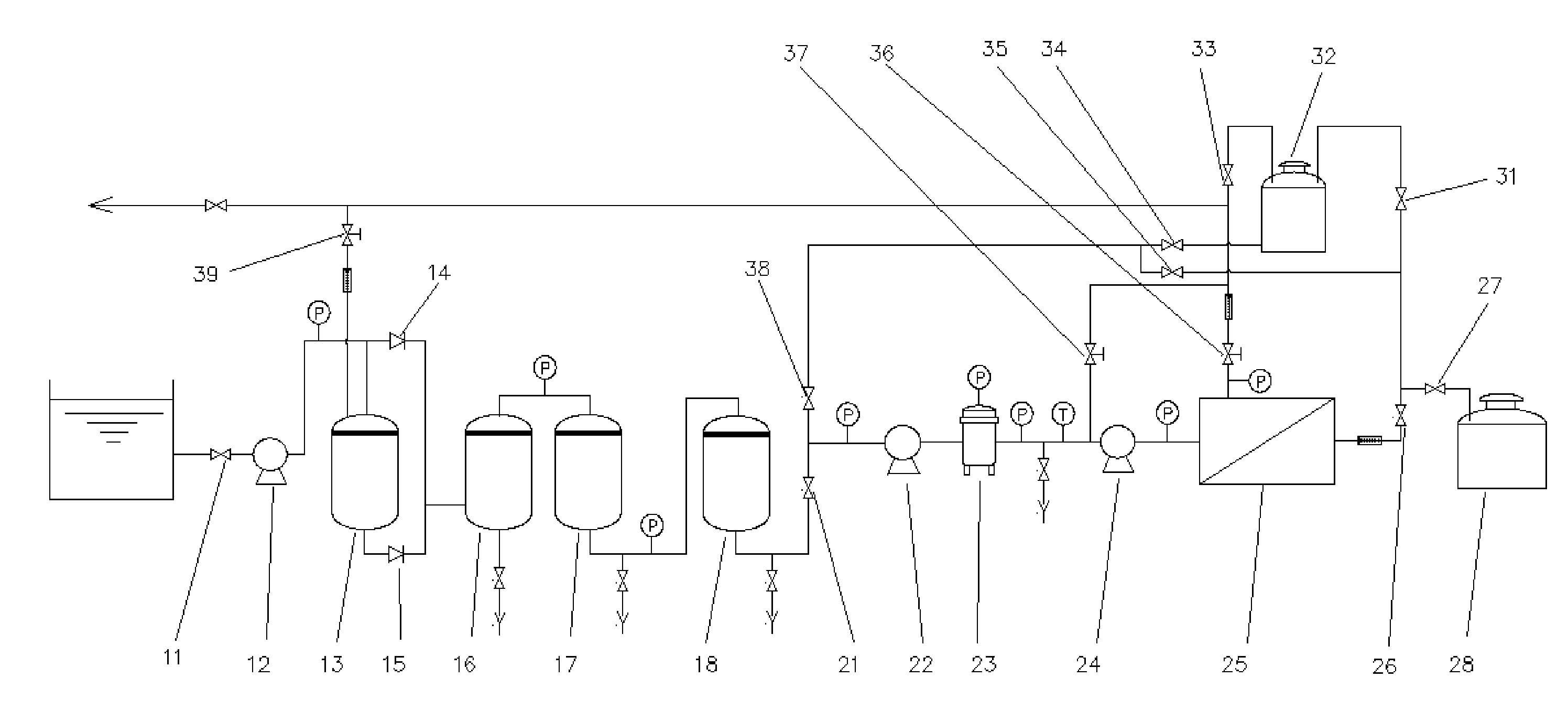Purifying device for deeply treating printing and dyeing wastewater, and purifying process therefor
a technology for deep treatment and printing and dyeing wastewater, applied in water/sewage multi-stage treatment, water/sewage treatment by electrochemical methods, filtration and other directions, can solve the problems of printing and dyeing components as environmental pollutants with many species and complex structures, and the environmental pollution of printing and dyeing components is more serious, so as to reduce the discharge of wastewater
- Summary
- Abstract
- Description
- Claims
- Application Information
AI Technical Summary
Benefits of technology
Problems solved by technology
Method used
Image
Examples
example 1
[0053]A process for purifying deeply treating printing and dyeing wastewater of 150 tons per day and reusing recycled water.
[0054]The deeply treating printing and dyeing wastewater has measured indexes shown in Table 1.
TABLE 1MeasuredNo.ItemUnitvalue1CODCrmg / L1562SSmg / L1103turbidityNTU64chromaticity805saltness‰6.66pH8.37conductivityμS / cm7200
[0055]The deeply treating printing and dyeing wastewater of 150 tons per day is drawn via the first pump 12 for 7.5T / H. At the beginning, a first part thereof flows into the nanometer catalytic microelectrolysis tank 13 via a T-cock for 1.5T / H, when the system runs stably and the concentrated liquid flows to recycle, a flow speed through the nanometer catalytic microelectrolysis tank 13 is adjusted to be 2.8T / H, after catalytic microelectrolysis, flows into the neutralization tank 16 via a first one-way valve 15, and a second part flows directly into the neutralization tank 16 to mix with the printing and dyeing wastewater purified by nanometer c...
example 2
[0059]A process for purifying deeply treating printing and dyeing wastewater of 3,000 tons per day and reusing recycled water.
[0060]The deeply treating printing and dyeing wastewater has measured indexes shown in Table 4.
TABLE 4MeasuredNo.ItemUnitvalue1CODCrmg / L1812SSmg / L1603turbidityNTU7.54chromaticity135pH7.66conductivityμS / cm6000
[0061]The deeply treating printing and dyeing wastewater is drawn via the first pump 12 for 150 T / H. A first part thereof flows into the nanometer catalytic microelectrolysis tank 13 via a T-cock for 50 T / H, when the system runs stably and the concentrated liquid flows to recycle, a flow speed through the nanometer catalytic microelectrolysis tank 13 is adjusted to be 75 T / H, wherein the deeply treating printing and dyeing wastewater is 50 T / H, the concentrated liquid after reflowing for catalytic microelectrolysis for 25 T / H, flows into the neutralization tank 16 via a first one-way valve 15, and a second part flows directly into the neutralization tank ...
example 4
[0071]A process for purifying deeply treating printing and dyeing wastewater of 20,000 tons per day and reusing recycled water.
[0072]The deeply treating printing and dyeing wastewater has measured indexes shown in Table 10.
[0073]The deeply treating printing and dyeing wastewater is drawn via the first pump 12 for 1000 T / H. A first part thereof flows into the nanometer catalytic microelectrolysis tank 13 via a T-cock for 250 T / H, when the system runs stably and the concentrated liquid flows to recycle, a flow speed through the nanometer catalytic microelectrolysis tank 13 is adjusted to be 360 T / H, wherein the deeply treating printing and dyeing wastewater is 250 T / H, the concentrated liquid after reflowing for catalytic microelectrolysis for 110 T / H, flows into the neutralization tank 16 via a first one-way valve 15, and a second part flows directly into the neutralization tank 16 to mix with the printing and dyeing wastewater purified by nanometer catalytic microelectrolysis for pr...
PUM
| Property | Measurement | Unit |
|---|---|---|
| current intensity | aaaaa | aaaaa |
| current intensity | aaaaa | aaaaa |
| pressure | aaaaa | aaaaa |
Abstract
Description
Claims
Application Information
 Login to View More
Login to View More - R&D
- Intellectual Property
- Life Sciences
- Materials
- Tech Scout
- Unparalleled Data Quality
- Higher Quality Content
- 60% Fewer Hallucinations
Browse by: Latest US Patents, China's latest patents, Technical Efficacy Thesaurus, Application Domain, Technology Topic, Popular Technical Reports.
© 2025 PatSnap. All rights reserved.Legal|Privacy policy|Modern Slavery Act Transparency Statement|Sitemap|About US| Contact US: help@patsnap.com


